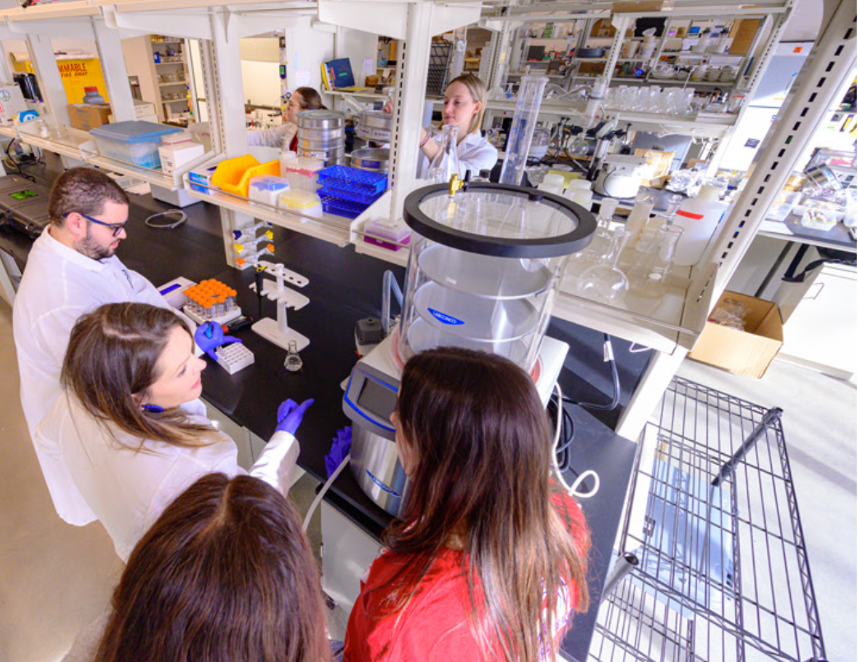Case Studies, Microplate Evaporators
/ Liz Gurkin
At American University in Washington, DC, Dr. Chelsea Koch relies on Organomation’s MICROVAP microplate evaporator for reliable sample processing of lipid extractions from sediments, animal tissue, and filtered seawater and fluxes. Her testing focuses on better understanding Arctic marine ecosystems and the consequences of climate change by looking at HBIs, or highly branched isoprenoids. Chelsea is looking for a highly branched isoprenoid biomarker that is unique to ice algae in the Arctic, and describes her research by saying:
"These compounds provide crucial insights into past sea ice conditions and, by extension, climatic shifts in the Arctic region. Through the analysis of sediment cores, sediment traps and sea ice samples, my work aims to reconstruct historical sea ice variability and understand its impact on the broader Arctic environment. This research is essential for predicting future changes in Arctic ice cover and assessing the potential consequences for global climate patterns.
Additionally, my research measures HBIs in animal tissues, providing a new way to trace dietary pathways in Arctic marine food webs. By detecting these biomarkers in various organisms, from small invertebrates to large marine mammals, we can highlight the importance of sea ice algae as a key food source. This analysis reveals how Arctic marine life depends on sea ice ecosystems and how changes in ice cover can affect the food web, potentially shifting species distribution and ecosystem stability. This part of my work enhances our understanding of ecological interactions and emphasizes the vital role of sea ice in supporting Arctic biodiversity.
To improve the accuracy of food web studies, we combine HBI measurements with fatty acids and stable isotope analysis. This method helps us better understand the feeding relationships in Arctic ecosystems. Stable isotopes of carbon and nitrogen trace nutrient flow from producers to top predators. When used alongside HBI data, this approach can identify the contributions of sea ice-associated production compared to open water phytoplankton. This thorough analysis not only reveals the current state of Arctic food webs but also helps predict how they might change due to shifting sea ice and global warming.
Furthermore, the use of compound-specific stable isotope analysis, particularly on museum archival samples, will enrich our understanding of historical shifts in primary production sources at the base of the Arctic food web. Analyzing these preserved samples allows us to track changes over time and assess how past sea ice conditions influenced the dietary patterns of marine species. This historical perspective is crucial for predicting future changes and preparing for their ecological impacts."
You can learn more about this important work on Chelsea's website.
For ice algae testing, Chelsea only ever sets her evaporator to 25°C. This low temperature is required so that her samples are not lost to thermal degradation or volatility. Chelsea was not able to use her evaporator, and time and money were being wasted without a solution to this issue. 
So, when her Classic model MICROVAP wasn’t able to meet her need for a lower temperature, we knew just the thing to solve it! Our new and improved MICROVAP is designed with scientists' feedback in mind, and its updated heating capabilities provide excellent stability for lower temperature applications, starting at room temperature as opposed to the previous model’s 40°C start point. With this change, she now reports that her new MICROVAP is “working great.” Being able to use the evaporator at a lower temperature meant that Chelsea was able to start running her tests again, and our trade-in program made for an easy swap. Curious to learn more? Here’s what her application looks like:
During the lipid extraction, Chelsea uses the evaporator to gently dry the hexane and concentrate the extracts. She does this twice in the procedure; first after the solid phase extraction, and then again after column chromatography, before the sample goes on to GC-MS analysis. Five to six milliliters of hexane per sample is gently removed at low heat by a steady stream of nitrogen gas. Chelsea usually evaporates eight samples at once, and it takes her about twenty to twenty-five minutes.
This is Chelsea’s first lab of her own, but not the first time she’s used one of our evaporators! Like many of our customers, Chelsea had a chance to use our equipment throughout her career, which made this “familiar and relatively easy to use” system that “takes up minimal space in the hood” an easy choice for her department. Ready to find the best evaporator for your lab? Take our “sample evaporator product finder” quiz, or get in touch with one of our sales representatives now to learn more!
